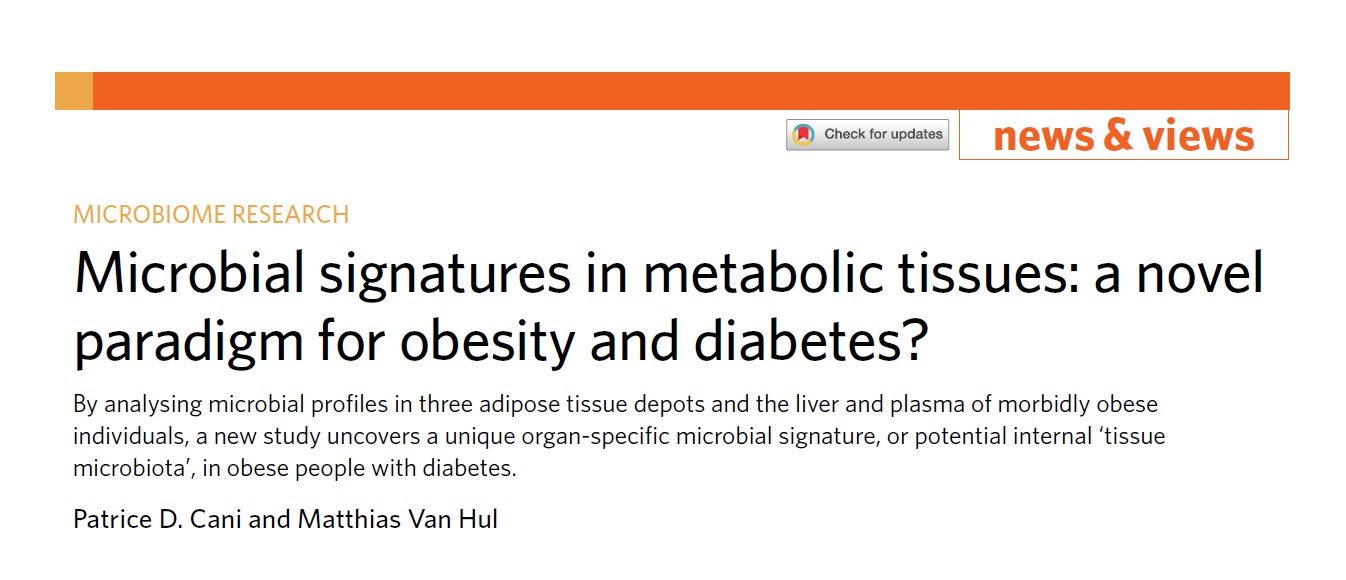Exploring the tissue microbiomes, from adipose tissue and liver, to understand the link between obesity and type 2 diabetes
In March 2020 on the cover of Nature Metabolism, Anhê and colleagues demonstrated why blood and tissue microbiomes are crucial to understanding the interactions between gut microbiota dysbiosis and metabolic diseases in humans. This paper was emphasized by a “News & Views” written by Patrice Cani and Matthias Van Hul, especially for having overcome previous concerns about potential contaminations and false-positive results when analyzing low bacterial biomass samples. Anhê and colleagues included an extensive set of negative controls from the operating room to 16S rRNA gene sequencing and therefore succeeded in providing clear and convincing data on blood and tissue microbiomes.
Translocation of bacterial products (DNA, LPS and others) is a known key player in the development of chronic low-grade inflammation and the pathogenesis of insulin resistance. In their study, Anhê et al. assessed the microbial profiles from three different adipose tissue depots (omental, mesenteric and subcutaneous), liver and plasma in obese subjects with or without type 2 diabetes. The subjects did not differ in their body mass index but they were significantly discriminated between diabetic and non diabetic by their adipose tissue bacterial signature. Most of these differences were observed in mesenteric adipose tissue. Diabetic patients had a higher relative abundance of Enterobacteriaceae corroborating previous studies that associated this bacterial family with poor glycaemic control. The genera Faecalibacterium, Odoribacter and Alistipes, previously linked to leanness and positive metabolic outcomes, were found in lower relative abundance in diabetic patients. These findings suggest that these taxa found in adipose tissue may play a modulator role in glucose homeostasis.
This landmark study paves the way towards understanding the link between gut microbiota, bacterial translocation, tissue microbiomes, systemic inflammation and metabolic disorders.
CITATIONS

Microbial signatures in metabolic tissues: a novel paradigm for obesity and diabetes?
Cani PD and Van Hul M. Nature Metabolism. 2020 Mar;2(3):211-212.
By analysing microbial profiles in three adipose tissue depots and the liver and plasma of morbidly obese individuals, a new study uncovers a unique organ-specific microbial signature, or potential internal ‘tissue microbiota’, in obese people with diabetes.

Type 2 diabetes influences bacterial tissue compartmentalisation in human obesity
In collaboration with Vaiomer
Anhê FF, Jensen BAH, Varin TV, Servant F, Van Blerk S, Richard D, Marceau S, Surette M, Biertho L, Lelouvier B, Schertzer JD, Tchernof A, Marette A. Nature Metabolism. 2020 Mar;2(3):233-242.
Visceral obesity is a key risk factor for type 2 diabetes (T2D). Whereas gut dysbiosis appears to be instrumental for this relationship, whether gut-associated signatures translocate to extra-intestinal tissues and how this affects host metabolism remain elusive. Here we provide a comparative analysis of the microbial profile found in plasma, liver and in three distinct adipose tissues of individuals with morbid obesity. We explored how these tissue microbial signatures vary between individuals with normoglycaemia and those with T2D that were matched for body mass index. We identified tissue-specific signatures with higher bacterial load in the liver and omental adipose tissue. Gut commensals, but also environmental bacteria, showed tissueand T2D-specific compartmentalisation. T2D signatures were most evident in mesenteric adipose tissue, in which individuals with diabetes displayed reduced bacterial diversity concomitant with fewer Gram-positive bacteria, such as Faecalibacterium, as opposed to enhanced levels of typically opportunistic Gram-negative Enterobacteriaceae. Plasma samples of individuals with diabetes were similarly enriched in Enterobacteriaceae, including the pathobiont Escherichia–Shigella. Our work provides evidence for the presence of selective plasma and tissue microbial signatures in individuals with severe obesity and identifies new potential microbial targets and biomarkers of T2D.
Expand your knowledge on the different microbiomes:

